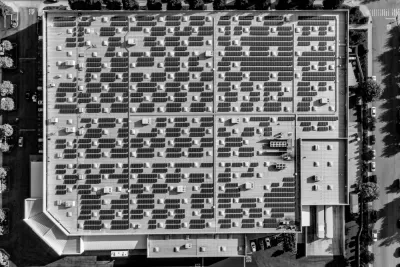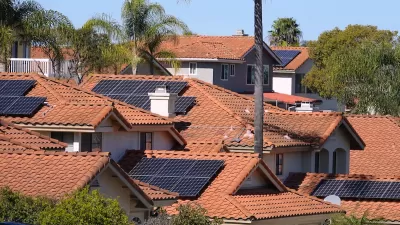The cheap price of solar and wind energy have corporations "falling all over themselves" to embrace renewable, according to this article. Target and Wal-Mart lead the green arms race.

Bruce Horovitz reports that big box stores, not exactly known for environmental friendliness in terms of transportation and land use, have wholeheartedly embraced the environmental friendliness of renewable energy, namely rooftop solar.
Take Target as an example, writes Horovitz:
Target is so serious about being viewed as a friend of the planet that by November, the company said, it will have erected rooftop solar panels on 500 of its stores in the United States. That’s more than one-quarter of its total 1,855 stores, and Target expects to reach that goal one year earlier than projected.
Target is now outpacing Wal-Mart, which was an early adopter of a large-scale solar installation program. "In its relentless bid to out-green archrival Walmart, Target also has ranked No. 1 in on-site solar capacity for three years in a row in the Solar Energy Industries Association’s Solar Means Business report, a survey of corporate solar users," according to Horovitz
The actions of Target and Wal-Mart reflect larger trends among large retails toward solar initiatives as a win for bottom lines and public images. And reneaable energy isn't just popular with big box stores. In total, "companies in the United States purchased three times as much power generated from solar and wind energy in 2018 than they did the year before," reports Horovitz.
FULL STORY: From the Rooftops, Big Box Stores Are Embracing Solar

Maui's Vacation Rental Debate Turns Ugly
Verbal attacks, misinformation campaigns and fistfights plague a high-stakes debate to convert thousands of vacation rentals into long-term housing.

Planetizen Federal Action Tracker
A weekly monitor of how Trump’s orders and actions are impacting planners and planning in America.

Chicago’s Ghost Rails
Just beneath the surface of the modern city lie the remnants of its expansive early 20th-century streetcar system.

Bend, Oregon Zoning Reforms Prioritize Small-Scale Housing
The city altered its zoning code to allow multi-family housing and eliminated parking mandates citywide.

Amtrak Cutting Jobs, Funding to High-Speed Rail
The agency plans to cut 10 percent of its workforce and has confirmed it will not fund new high-speed rail projects.

LA Denies Basic Services to Unhoused Residents
The city has repeatedly failed to respond to requests for trash pickup at encampment sites, and eliminated a program that provided mobile showers and toilets.
Urban Design for Planners 1: Software Tools
This six-course series explores essential urban design concepts using open source software and equips planners with the tools they need to participate fully in the urban design process.
Planning for Universal Design
Learn the tools for implementing Universal Design in planning regulations.
planning NEXT
Appalachian Highlands Housing Partners
Mpact (founded as Rail~Volution)
City of Camden Redevelopment Agency
City of Astoria
City of Portland
City of Laramie





























